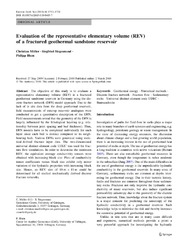Evaluation of the representative elementary volume (REV) of a fractured geothermal sandstone reservoir
Zeitschrift: Environmental Earth Sciences, 201061, 8: 1713 - 1724
DOI: https://doi.org/10.1007/s12665-010-0485-7
Persistent URL: http://resolver.sub.uni-goettingen.de/purl?gldocs-11858/6775
Persistent URL: http://resolver.sub.uni-goettingen.de/purl?gldocs-11858/6775
Müller, Christian; Siegesmund, Siegfried; Blum, Philipp, 2010: Evaluation of the representative elementary volume (REV) of a fractured geothermal sandstone reservoir. In: Müller, Christian; Siegesmund, Siegfried; Blum, Philipp (2010): Evaluation of the representative elementary volume (REV) of a fractured geothermal sandstone reservoir - Environmental Earth Sciences, Vol. 61, Nr. 8, p. 1713-1724, DOI: 10.1007/s12665-010-0485-7.
 |
Dokument öffnen: |
The objective of this study is to evaluate a representative elementary volume (REV) in a fractured geothermal sandstone reservoir in Germany using the discrete fracture network (DFN) model approach. Due to the lack of in situ data from the deep geothermal reservoir, field measurements of outcrop reservoir analogues were conducted to get a quantitative description of the DFN. Field measurements reveal that the geometry of the DFN is largely influenced by the lithological layering (e.g. relationship between joint spacing and bed thickness). Thus, DFN models have to be completed individually for each layer since each bed is distinct compared to its neighbouring beds. Various DFNs were generated using statistical-derived fracture input data. The two-dimensional universal distinct element code UDEC was used for fracture flow simulations. In order to determine the minimum REV, the equivalent average conductivity tensors were obtained with increasing block size. Plots of conductivity tensor coefficients versus block size exhibit only minor variation of the hydraulic properties with increasing block size. Hence, an REV size of 10 m × 10 m could be determined for all studied stochastically derived discrete fracture networks.
Statistik:
ZugriffsstatistikSammlung:
- Geologie [933]

